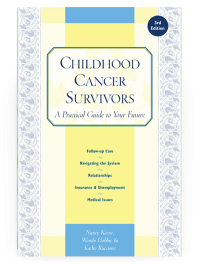Childhood Cancer Survivors
Chapter 6. Diseases
The world breaks everyone and afterward many are strong at the broken places.
— Ernest Hemingway A Farewell to Arms
SURVIVORSHIP continues throughout your life. Whether you develop any late effects from your treatment for childhood cancer depends on your disease, your age at diagnosis, your sex, the treatment received, genetic predisposition, and complications you had during treatment. For many cancers, treatment toxicity has lessened over the years; for others, eliminating the cancer comes at a higher price.
This chapter is divided into sections that describe the major cancers of childhood and adolescence in alphabetical order: acute lymphoblastic leukemia (ALL), acute myelogenous leukemia (AML), brain tumors, Ewing sarcoma, Hodgkin lymphoma (formerly called Hodgkin’s disease), neuroblastoma, non-Hodgkin lymphoma (NHL), osteosarcoma, rare cancers, retinoblastoma, rhabdomyosarcoma, and Wilms tumor. Brief descriptions of the cancers, their treatments, and possible late effects are included. Because many diseases are now treated with stem cell transplants (which includes bone marrow, stem cell, and cord blood transplants), a separate section about this topic is included after the disease sections. At the end of the chapter are tables listing the treatments used and some of the tests you may need to monitor your health.
These tables and the Children’s Oncology Group’s follow-up guidelines ( www.survivorshipguidelines.org ) will help you better understand your risks based on the treatment you received and can help you make choices that lessen your chances of developing a particular problem. For instance, if you are at increased risk for heart disease, you can decrease the full impact of this risk by eating a healthy diet, doing the right kinds of exercise, and not smoking.
The tables will help you keep all medical caregivers updated on the follow-up necessary to maximize your health. For this information to be most helpful, ask your oncologist or nurse practitioner to fill in the Cancer Survivor’s Treatment Record (at the back of this book) or give you a treatment summary so you know which sections of the tables apply to you.
Adult survivors of childhood cancer are pioneers; researchers are still learning about effects of earlier treatments as survivors grow and age. The late effects from current protocols may not be completely understood for decades. Therefore, at the time of diagnosis, it is not possible to predict all potential long-term effects. Even with known late effects, there is considerable variation from person to person. Just because it may happen does not mean it will happen.
Heather was diagnosed with stage IV neuroblastoma, a very, very aggressive type of solid tumor, when she was 14 months old. They only gave her a less than 10 percent chance to live. Given this, we opted to take the most aggressive route, toxicities, risks, and all. Basically, we were more afraid of that neuroblastoma than anything else. Well, miraculously, 6 years later, Heather is with us today. They told us that she would have severe hearing loss (her hearing is perfect), she would be very short (she’s not), she would have cardiac problems (she doesn’t), and she would have learning disabilities and be socially delayed (she is superior in all intelligence tests, in all advanced classes, and very outgoing and well-adjusted). They also said that she would probably be sterile, but I’m not going to count on that one, either, and I’ll make sure that neither does she.
• • • • •
Joan was diagnosed with high-risk ALL when she was 3 years old. She was treated with high-dose chemo and cranial radiation. We are grateful that she survived, but she has many late effects. She had problems with growth and an early puberty, and currently has endocrine problems, learning disabilities, and social difficulties (because she doesn’t process verbal communication very quickly and she doesn’t understand nonverbal communication very well).
Certain groups of children, adolescents, and young adult survivors are more at risk for side effects than others. Reading the following sections for details about late effects and getting thorough follow-up care will maximize your chance for a long and healthy life and prepare you to talk over any questions or concerns with your healthcare provider. All of the statistics in the following sections are from the National Cancer Institute (NCI) website ( www.cancer.gov/cancertopics/pdq/pediatrictreatment ) and an NCI publication titled Cancer Incidence and Survival Among Children and Adolescents . 1
Table of Contents
All Guides- 1. Survivorship
- 2. Emotions
- 3. Relationships
- 4. Navigating the System
- 5. Staying Healthy
- 6. Diseases
- 7. Fatigue
- 8. Brain and Nerves
- 9. Hormone-Producing Glands
- 10. Eyes and Ears
- 11. Head and Neck
- 12. Heart and Blood Vessels
- 13. Lungs
- 14. Kidneys, Bladder, and Genitals
- 15. Liver, Stomach, and Intestines
- 16. Immune System
- 17. Muscles and Bones
- 18. Skin, Breasts, and Hair
- 19. Second Cancers
- 20. Homage
- Appendix A. Survivor Sketches
- Appendix B. Resources
- Appendix C. References
- Appendix D. About the Authors
- Appendix E. Childhood Cancer Guides (TM)

